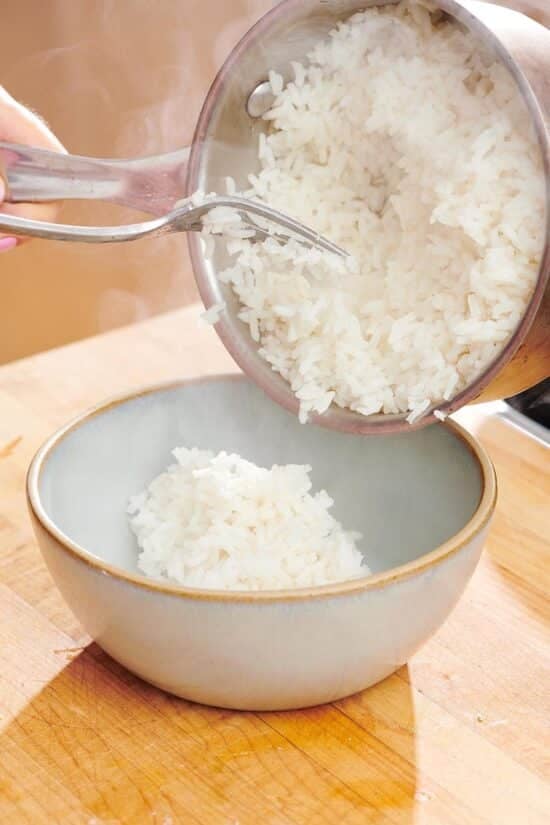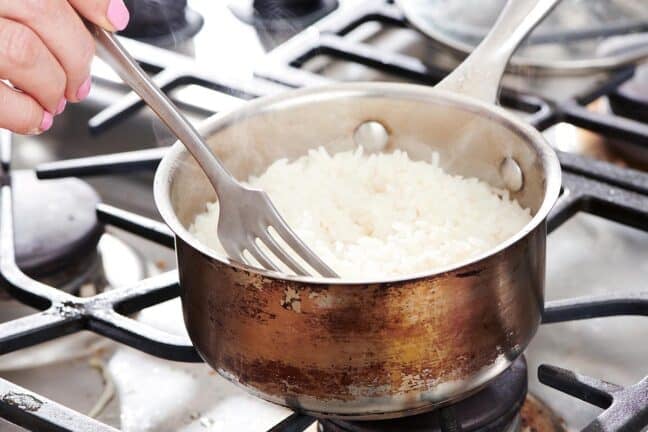The most common staple food consumed worldwide is rice, but many people, particularly in the West, admit they don’t know how to properly prepare it. There are so many different techniques that cookbook authors and TV chefs employ that it’s understandable why it might be confusing.
If you adhere to a few fundamental guidelines, cooking boiled rice is actually very simple. This instruction manual on how to prepare rice is intended to help you consistently produce perfect, fluffy results. Never again will you have a stodgy mass or rice that is chalky.
What is the Ratio of Water to Rice?
The basic water to white rice ratio is 2 cups water to 1 cup rice. You can easily, double and even triple the recipe; just make sure you are using a pot large enough to hold the rice as it cooks and expands. Other rice varieties, like brown and Arborio, can be a little different in terms of proportions and timing, but this 2 to 1 ratio is how you’ll get perfect white rice every time.

You should add the rice after bringing the water to a boil and seasoning it with salt and possibly a little butter. Then just let the water come back to a boil. The water and rice will then be kept at a simmer, which is basically just below the boiling point, while the heat is quickly reduced, the pot is covered, and the rice is cooked. Instead of boiling the liquid to a full boil, which might cause the water to bubble up out of the pot, you want the liquid’s surface to be gently bubbling.
Bring the water to boil in a medium saucepan. Salt and butter are added; let the butter melt.
Stir in the rice once the water has boiled again. Let the water return to a light simmer. Stir once more, cover the pan, and reduce the heat to low Keep the rice simmering and cover the pot (you might need to peek after a few minutes to make sure the heat is at the right level, but then let it cook, covered) to prevent the rice from burning. At around 17 minutes, start examining the rice to see if it is tender and that all the liquid has been absorbed. It could take up to 25, particularly if you are making more rice.
When the rice is finished cooking, turn off the heat and let it stand for a few minutes so that it can fully absorb any liquid. Remove the lid, fluff the rice with a fork, and let it sit for an additional two minutes or so to allow some of the excess moisture to evaporate.

So I researched cooking rice via sous vide and found some interesting information. The most comprehensive information was contained in a video from America’s Test Kitchen’s Dan Souza that explains water to rice ratios and why sous vide cooking consistently succeeds where other methods may have variable results. The gist of the video is to cook white rice using sous vide in a 1 to 1 water to rice ratio at 200º F for 25 minutes. There are many benefits when using this approach, so here are just a few. First, the results are incredible every time. Second, the portion is perfect for one ‘single diner’ meal. Third, the timing is spot on so you can time the remainder of your meal to finish when the rice is done. Fourth, the possibilities of seasoning or flavorings you can cook/infuse into the rice are endless. And last, it is really simple and clean-up is a breeze! So, are you ready to up your rice cooking game? If you are, set up your sous vide water bath and let’s get cooking!
Recently, I’ve been using sous vide to prepare a variety of staple side dishes, and I thought it was time to start sharing them with you. The first of these posts (apart from the Mashed Potato for One post I wrote at this time last year) is cooking white rice for one. I know it may seem boring and a little redundant to write about cooking rice, but trust me, this is great information for cooking small amounts of rice perfectly while helping you minimize waste or to help you from over indulging! I’ll admit that rice frequently appears in my recipes, but it can be challenging to prepare the right amount for a single serving. I’ve tried cooking rice on the stovetop in my smallest pot, in the microwave, and in a traditional rice cooker. They all failed me in some manner. First off, none of these methods can successfully cook 1/2 cup of rice to my satisfaction. All of these techniques can cook 1 cup, but they have drawbacks. The stove top lacks consistency. When using the small pot, the main challenge is adjusting the heat just right. Too hot and scorched rice with a funky, bitter taste. When it’s too cool, the rice takes longer to cook and instead soaks With longer cooking times, the results are more mushy. The microwave cooker consistently delivers serviceable results, but it frequently leaves a boiled-over mess inside the microwave, which adds to the cleanup effort—and nobody likes that. The rice cooker yields the best results in the shortest amount of time, but typically some rice gets stuck on the cooker’s bottom. I want every grain of rice I cook for a meal to be cooked, and I want the cleanup to take less time.
The sous vide water bath should be set for 200 degrees F. Rinse the rice to remove any surface starch. Add the rice, salt, seasonings (if using), and water (or broth) to a resealable bag. Remove as much air as you can before closing by using the water displacement technique. Put the bag in the water bath and secure it with a clip. Remove the bag and empty it into a bowl after 25 minutes. Lightly fluff the rice with a fork.
The Pasta Method
Unexpectedly, you can prepare rice similarly to pasta in an arbitrary amount of water. For varieties of rice like brown rice and wild rice, which take a long and occasionally unpredictable amount of time to cook, this is a great method. It’s also a clever method for cooking a large quantity of any type of rice without a rice cooker. Because there is so much more water that needs to be kept at a constant simmer, it can be challenging to perfect large batches of rice cooked using the traditional method. Heres what to do instead.
Even though it’s simple, making brown rice can be challenging when attempting to achieve the ideal not-too-chewy, not-too-soggy texture. Discover how to prepare brown rice perfectly each and every time!
There are a few clever techniques you can employ when cooking aromatic rice varieties like Basmati and Jasmine to bring out their naturally nutty flavor.
